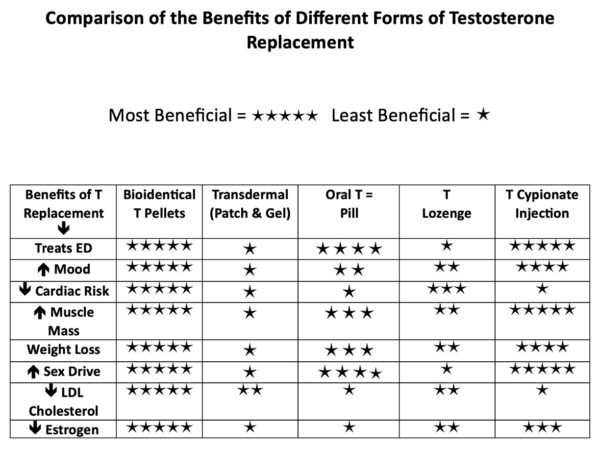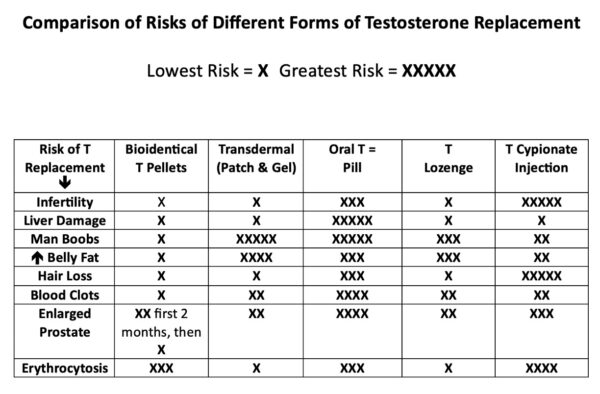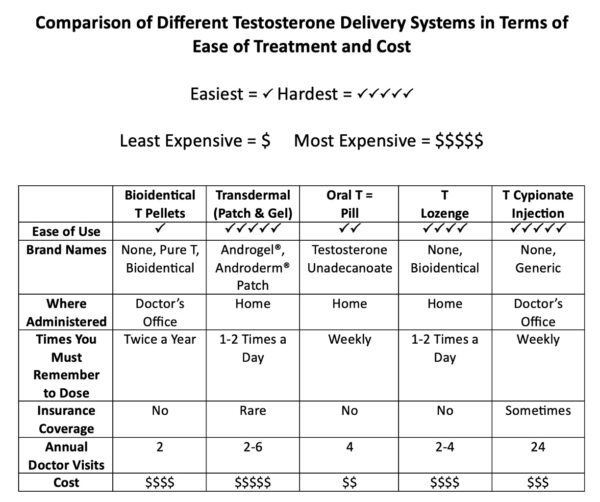Not all testosterone delivery methods deliver the same result.
My medical practice at BioBalance® Health brings me many interesting issues that my patients have had to struggle with, before they finally come to me for T Pellets. The latest complaint that men bring to me on their first visit is their reticence to try T pellets because they already tried T cream, or T gel or T patches and they did not get the results that they expected and needed, so they believe T Pellets won’t help them either. Another problem the other forms of T can pose for men is that they try non-pellet forms of T and tell me that they felt a little bit better and they tell me that is all they thought they would get from any form of T replacement….they settle for feeling slightly better instead of feeling Completely Well!
Compared to FDA approved Testosterone Creams, Gels, and Patches, Testosterone Pellets at BioBalance Health are superior in every way! When deciding on a treatment or even when buying an important item for your home you should do your homework! I am going to tell you today why men should switch to long-acting Bio-identical testosterone pellets instead of the other forms.
Deciding between various forms of Testosterone
#1 Effectiveness of each form of Testosterone
When making a decision about which treatment to employ, you should look at whether the treatment will completely treat my symptoms, or just some of them/ and what are the side effects (what is the downside)? Below is a comparison from my book for men, “Got Testosterone?” that compares T pellets to other forms. Note that Creams/Gels/patches are all “Transdermal”, or delivered through the skin:

The reasons for why the quality of the treatment is different for trans-dermals and pellets is because the up to 80% of testosterone converts into estrogen as it is absorbed by the skin. Men don’t need or tolerate estrogens like women do, in fact estrogen binds up testosterone so it can’t be used by the body. So, gels, creams and patches give a man a small amount of T, but soon it inactivates the testosterone, and doctors think the dose is too low, so they raise the dose. The same thing happens over again and finally both doctor and patient give up and generalize the treatment failure and assume the man cannot take Testosterone (in any form).
Pellet testosterone dissolves under the skin in a layer of fat and goes directly into the bloodstream where it goes to work and attached to Testosterone receptor sights. A small amount is converted into estrogen, but it is not enough to inactivate the testosterone from the pellet, so the effectiveness of Pellet Testosterone is quite different from transdermal forms of testosterone, and is greatly superior.
#2 Side Effects/Risks
The flipside of whether a medical treatment of any kind is right for you, is the risks of the treatment and the likelihood of side effects. Knowing the effectiveness of a treatment and the risks, helps you decide whether it will work for you. Knowing these two most important factors help a patient make a decision on which treatment he wants to try.
The comparison of side effects of the different forms of testosterone is below:

There are risks that may not apply to you, however you should look to the side effects or risks that apply to you, to make your decision. In the table the highest risk is noted with three Xs, and the lowest risk is one X. The side effects of T in Pellets are much lower than other forms of Testosterone. You must review whether these are risks for you individually or not.
For example, if you are still of childbearing age or you still want more children than the lowest risk of infertility is offered by T Pellets, however there is still a risk. For those men who don’t have hemochromatosis then this risk is not a risk at all. This really means that risks must be individualized for each man just like dosage.
#3 Ease of Complying with Dosage and #4 Cost
Whether you can actually continue treatment for a long period of time is pivotal to determine whether you should take a type of Testosterone replacement. You should look at these factors:
- Can I realistically follow the dosing schedule?
- How many times a year do I have to go to the doctor’s office for this treatment?
- How much time will I waste a month waiting in a doctor’s office to get the treatment?
- Is it administered at home or at the doctor’s office?
The next part of this equation is the cost of treatment. Most testosterone medications are not paid for by insurance. If they are paid for, they have a high copay for most insurance. If you get your testosterone from a pharmacy, then to compute your fee you should multiply the copay by 11 months. If you have to go to the doctor to get the script, you should add the doctor’s fee as well.
I have compiled the cost of each kind of treatment based on the initial dose, which might not be adequate for people who use trans-dermal testosterone and need to increase the dose multiple times.

Take a look at both the dosing schedule and the cost of treatment, and remember that treatment that doesn’t work, is very expensive because you are buying something that doesn’t work! As for dosing, If you can’t remember your vitamins, your medicine or to brush your teeth before you go to bed I can guarantee that you won’t be able to remember your testosterone cream or gel, or pill.
In the End it is Your decision
Everyone must make their own decision about what type of Testosterone to use. Only you know whether you can be compliant with a daily regimen or would be better to come to an office to get your testosterone twice a year. Only you know whether an effective form of T like pellets is worth the cost of treatment, however, to make a good decision you should compute the daily or monthly cost of the pellets to compare apples to apples.
I see many men who have tried T shots, gels and patches, and come to me as a last chance to treat their low T symptoms with pellets. 98% of them are extremely happy and continue treatment, noting the difference between pellets and their previous T treatment. If you continue to use gels and creams because the FDA approves of it, or because your PCP orders it, but you don’t feel better, then you should try T pellets!
This Health cast was written and presented by Dr. Kathy Maupin, M.D., Bio-identical Hormone Replacement Expert and Author. www.BioBalanceHealth.com • (314) 993-0963. Please subscribe to our YouTube channel and please check “ Like “. Follow us on Facebook and Instagram at BioBalanceHealth.

